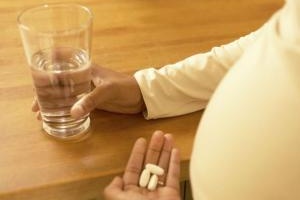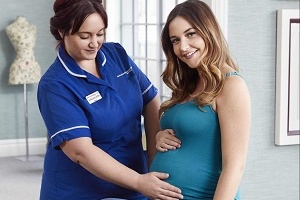It affects two million women in the UK so if you’re suffering, you’re definitely not alone. Here’s all the information you need
What is endometriosis?
It can be a long-term condition that can have a significant impact on your general physical health, emotional wellbeing and daily routine (NICE, 2017; RCOG, 2018). It's where tissue that’s similar to the inner lining of the womb (endometrium) grows outside of the womb. This tissue might grow in places like the bowel, bladder, ovaries, fallopian tubes or the lining of the abdomen (UCLH, 2018).
Endometriosis is one of the most common gynaecological diseases needing treatment (NICE, 2017).
Is that why endometriosis is often linked to infertility?
Yes. The problems caused by endometriosis, particularly in women who have moderate and severe cases, can make it difficult for them to get pregnant (Endometriosis UK, 2008).
This is thought to be because of damage to the fallopian tubes or ovaries (NHS, 2019).
How is endometriosis diagnosed?
It can be as simple as talking through your symptoms, period history and mentioning any pain during or after sex. If it is still unclear whether you have it, endometriosis can be diagnosed with a pelvic examination, an ultrasound scan or a laparoscopy (a tube with a tiny camera) (UCLH, 2018; NHS, 2019).
If someone has endometriosis, will they be able to get pregnant?
Probably. Most women (60-70%) with endometriosis will get pregnant in the end, without treatment (Endometriosis, 2008; NHS, 2019). It depends how severe your symptoms are (Rossi and Prefumo, 2016).
If there is difficulty getting pregnant, infertility treatments, such as in vitro fertilisation (IVF), may be an option. But women with moderate to severe endometriosis tend to have a lower chance of getting pregnant with IVF than usual (NHS, 2019).
What are the signs and symptoms of endometriosis?
The misplaced tissue will continue to behave like the endometrial tissue in your womb and bleed during your period. This may cause severe period pain as well as bleeding between periods, inflammation, cysts and scarring. It can also cause pain in the lower abdomen, pelvis or lower back, and pain during and after sex (NHS Inform, 2018).
Endometriosis can cause pain that occurs in a regular pattern, becoming worse before and during your period. Some women experience pain all the time but for others it may come and go. The pain may get better during pregnancy and sometimes it might disappear without any treatment (RCOG, 2018).
Other endometriosis symptoms can include persistent exhaustion and tiredness, discomfort going to the toilet and bleeding from the back passage or blood in your poo (NHS Inform, 2018).
How common is endometriosis?
Endometriosis affects around one in ten women in their reproductive years (RCOG, 2018). That is around two million women in the UK.
What causes endometriosis?
This is a tricky one. The exact cause is still unknown but a few factors are probably at play.
For most women, some of the inner lining of the womb flows backwards during their period through the fallopian tubes and into the abdomen. But while the body normally clears these tissues, for women with endometriosis the tissue attaches to the pelvic or abdominal organs or the abdominal wall (Endometriosis UK, 2008).
Why do some women get endometriosis and others don't?
Possibly because of a weaker immune system (Jerman and Hey-Cunningham, 2015). Genetics – family history of endometriosis – may also play a role (Kennedy et al, 1995; Simpson and Bischoff, 2002; Stefansson et al, 2002). Environmental factors like toxins that affect the immune and reproductive systems might be involved too (Louis et al, 2013; Porpora et al, 2013).
Other potential causes are metaplasia, which is where one type of cell changes into another to adapt to its environment. Some research suggests that in women with endometriosis, certain abdominal cells mistakenly turn into endometrial cells (Healthy Women, 2018).
Lymphatic spread may be another factor (Jerman and Hey-Cunningham, 2015). This is where tiny bits of endometriosis tissue travel around the body through the lymphatic system.
What’s the treatment for endometriosis?
The pain is managed with painkillers like ibuprofen and paracetamol (NHS, 2019). The most common way to treat endometriosis itself is with hormones like gonadotrophin-releasing hormone analogues (GnRH) and contraceptives like the pill (NHS, 2019). They work by limiting or stopping the production of oestrogen, which is the hormone that encourages the growth of endometrial tissue (UCLH, 2018). They can also stop periods, easing symptoms.
Hormonal treatments would not be offered to a women trying to conceive (NICE, 2017).
Some women develop adhesions – sticky areas of endometriosis tissue that join organs together, or fluid-filled ovarian cysts. These can be treated with surgery (NHS, 2019).
What are the risks of hormone treatment for endometriosis?
Some women experience no side effects to hormone treatment, while others may experience some of the following symptoms:
- Hot flushes
- Decreased sex drive (libido)
- Mood changes
- Breast changes
- Insomnia.
These side effects generally reduce within a few weeks to months of completing treatment. With longer use, osteoporosis may also occur (UCLH, 2018).
Hormonal treatment is not advisable when you are trying to conceive and surgical treatment may be more appropriate. Your healthcare professional should provide you with information about your options and arrange timely referral to a fertility specialist if appropriate (RCOG, 2018).
Surgery to remove endometriosis tissue can help improve the chances of getting pregnant, although there's no guarantee that you'll be able to get pregnant after treatment. Surgery for endometriosis can also sometimes cause further problems, such as infections, bleeding or damage to affected organs. Before having surgery, talk to your surgeon about the benefits and possible risks involved (NHS, 2019).
What is the treatment for endometriosis if I’m trying to conceive?
Right now, there is no suitable treatment for managing endometriosis while trying to conceive if the condition is making it difficult for you to get pregnant. Opinions are mixed over whether surgery to remove the endometrial tissue and ease endometriosis symptoms could help with trying to conceive (Nickkho-Amiry et al, 2018; NHS, 2019).
Some women have found the following measures helpful to manage the symptoms of endometriosis:
- Exercise, which may improve your wellbeing and may help to improve some symptoms of endometriosis.
- Cutting out certain foods, such as dairy or wheat products from the diet.
- Psychological therapies and counselling.
(RCOG, 2018)
Although there is only limited evidence for their effectiveness, some women may find the following therapies help to reduce pain and improve their quality of life:
-
Reflexology
-
Transcutaneous electrical nerve stimulation (TENS)
-
Acupuncture
-
Vitamin B1 and magnesium supplements
-
Traditional Chinese medicine
-
Herbal treatments
-
Homeopathy.
(RCOG, 2018)
Is there anything else that can help someone with endometriosis conceive?
Several types of fertility treatments are available for women with endometriosis who are having trouble conceiving. They include IVF, intrauterine insemination (IUI), ovarian stimulation with IUI and gamete intrafallopian tube transfer (GIFT) (Endometriosis UK, 2008). That’s a lot of medical terms...
Your carers can suggest which treatment is most appropriate depending on your particular situation.
If pregnancy happens, will endometriosis affect it?
Pregnancy in a person with endometriosis should be no different than in a person without it. Some women have more pain in the early months, but generally pain improves. However, it may return when periods reappear (Endometriosis UK, 2008).
What about breastfeeding?
Studies have shown breastfeeding to be beneficial in alleviating the symptoms of endometriosis. This is due to the changes in hormones and amenorrhoea (absence of periods).
Mothers who breastfeed are less likely to develop endometriosis. The longer the duration of exclusive breastfeeding, the greater the decrease in risk of endometriosis. For each pregnancy, every three month increase in exclusive breastfeeding per pregnancy was linked to a 14% decreased risk for endometriosis (Farland et al, 2017).
What effect does endometriosis have on partners?
Endometriosis can have a significant impact on quality of life, not just for women with the condition but also for those who are close to them – including partners, family and friends (Endometriosis UK, 2016).
Take a look here for details of support for partners of someone with endometriosis (the link includes a video) (Endometriosis UK, 2016).
Is there anywhere people can go for support?
Yes, absolutely. Try Endometriosis UK and speak to your GP if you are experiencing anxiety or depression due to endometriosis.
This page was last reviewed in March 2021.
Further information
Our support line offers practical and emotional support with feeding your baby and general enquiries for parents, members and volunteers: 0300 330 0700.
We also offer antenatal courses which are a great way to find out more about birth, labour and life with a new baby.
NHS choices provides information on the diagnosis and treatment of the condition and its effect on fertility.
Endometriosis UK aims to improve the lives of people affected by endometriosis and work towards a future where it has the least possible impact on those living with endometriosis.
The Royal College of Obstetricians & Gynaecologists has this useful information sheet about endometriosis.
Bischoff F, Simpson JL. (2004) Genetic basis of endometriosis. Ann N Y Acad Sci. 1034:(284-299). Available at: https://www.ncbi.nlm.nih.gov/pubmed/15731320 [Accessed 23rd March 2021].
Endometriosis UK. (2008) Endometriosis, fertility, and pregnancy. Available at: https://www.endometriosis-uk.org/sites/default/files/files/Information/fertility.pdf [Accessed 23rd March 2021].
Endometriosis UK. (2016) Endometriosis and couples. Available at: https://www.endometriosis-uk.org/endometriosis-and-couples [Accessed 23rd March 2021].
Farland L, Eliassen A, Tamimi R, Spiegelman D, Michels K, Missmer S. (2017) History of breast feeding and risk of incident endometriosis: prospective cohort study. BMJ. 358:j3778. Available at: https://www.bmj.com/content/358/bmj.j3778 [Accessed 23rd March 2021].
Jerman LF, Hey-Cunningham AJ. (2015) The role of the lymphatic system in endometriosis: a comprehensive review of the literature. Biol Reprod. 92(3):64. Available at: https://www.ncbi.nlm.nih.gov/pubmed/25588508 [Accessed 23rd March 2021].
Kennedy S, Mardon H, Barlow D. (1995) Familial endometriosis. J Assist Reprod Genet. 12(1):32-34. Available at: https://www.ncbi.nlm.nih.gov/pubmed/7580007 [Accessed 23rd March 2021].
Louis GMB, Peterson CM, Chen Z, Croughan M, Sundaram R, Stanford J, Sun L. (2013) Bisphenol A and phthalates and endometriosis: the endometriosis: natural history, diagnosis and outcomes study. Fertil Steril. 100(1):162-169. Available at: https://www.ncbi.nlm.nih.gov/pubmed/23579005 [Accessed 23rd March 2021].
NHS. (2019) Endometriosis. Available from: https://www.nhs.uk/conditions/endometriosis/ [Accessed 23rd March 2021].
NHS Inform. (2018) Endometriosis. Available from: https://www.nhsinform.scot/illnesses-and-conditions/sexual-and-reproductive/endometriosis [Accessed 23rd March 2021].
NICE. (2017) Endometriosis: diagnosis and management Available from: https://www.nice.org.uk/guidance/ng73/chapter/Recommendations [Accessed 23rd March 2021).
Nickkho-Amiry M, Savant R, Majumder K, Edi-O’sagie E, Akhtar M. (2018) The effect of surgical management of endometrioma on the IVF/ICSI outcomes when compared with no treatment? A systematic review and meta-analysis. Arch Gynecol Obstet. 297(4):1043-1057. Available at: https://www.ncbi.nlm.nih.gov/pmc/articles/PMC5849664/ [Accessed 23rd March 2021].
Porpora MG, Resta S, Fuggeta E, Storelli P, Megiorni F, Manganaro, De Felip E. (2013) Role of environmental organochlorinated pollutants in the development of endometriosis. Clin Exp Obstet Gynecol. 40(4):565-567. Available at: https://www.ncbi.nlm.nih.gov/pubmed/24597257 [Accessed 23rd March 2021]
RCOG. (2018) Endometriosis. Available at: https://www.rcog.org.uk/en/patients/patient-leaflets/endometriosis/ [Accessed 23rd March 2021].
Rossi AC, Prefumo F. (2016) The effects of surgery for endometriosis on pregnancy outcomes following in vitro fertilization and embryo transfer: a systematic review and meta-analysis. Arch Gynecol Obstet. 294(3):647-55. Available at: https://www.ncbi.nlm.nih.gov/pubmed/27300002 [Accessed 23rd March 2021].
Stefansson H, Geirsson RT, Steinthorsdottir V, Jonsson H, Manolescu A, Kong A, et al. (2002) Genetic factors contribute to the risk of developing endometriosis. Human Reprod. 17(3):555-559. Available at: https://www.ncbi.nlm.nih.gov/pubmed/11870102 [Accessed 23rd March 2021].
UCLH. (2018) General information about endometriosis. Available at: https://www.uclh.nhs.uk/our-services/find-service/womens-health-1/gynae… [Accessed 23rd March 2021].
Further reading
Albertsen HM, Chettier R, Farrington P, Ward K. (2013) Genome-wide association study link novel loci to endometriosis. PloS one. 8(3):e58257. Available at: https://www.ncbi.nlm.nih.gov/pmc/articles/PMC3589333/ [Accessed 23rd March 2021].
Di W, Guo SW. (2007) The search for genetic variants predisposing women to endometriosis. Curr Opin Obstet Gynecol. 19(4):395-401. Available at: https://www.ncbi.nlm.nih.gov/pubmed/17625425 [Accessed 23rd March 2021].
Macer ML, Taylor HS. (2012) Endometriosis and infertility: a review of the pathogenesis and treatment of endometriosis-associated infertility. Obstet Gynecol Clin North Am. 39(4):535-549. Available at: https://www.ncbi.nlm.nih.gov/pmc/articles/PMC3538128/ [Accessed 23rd March 2021].
Painter JN, Anderson CA, Nyholt DR, Macgregor S, Lin J, Lee SH, et al. (2011). Genome-wide association study identifies a locus at 7p15. 2 associated with endometriosis. Nat Genet. 43(1):51-54. Available at: https://www.ncbi.nlm.nih.gov/pmc/articles/PMC3019124/ [Accessed 23rd March 2021].
Uno S, Zembutsu H, Hirasawa A, Takahashi A, Kubo M, Akahane T, et al. (2010) A genome-wide association study identifies genetic variants in the CDKN2BAS locus associated with endometriosis in Japanese. Nat Genet. 42(8):707-710. Available at: https://www.ncbi.nlm.nih.gov/pubmed/20601957 [Accessed 23rd March 2021].







